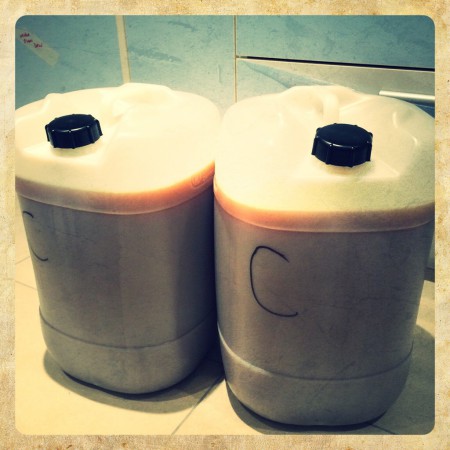I’ve bought 50 litres of freshly-pressed, unpasturised, unfiltered apple juice as part of a National Homebrew Club group buy. The juice is a blend of real cider varieties, comprising of Dabinett and Michelin. There is also a small proportion of Karmijn de Sonnaville and Bramley in the juice to balance the acidity.
All of my previous cider-making endeavours have been turbo cider efforts. Very drinkable for my taste, but I’d say the more sophisticated cider afficionadoes would find the flavour coarse and palate-strippingly dry.
As this is a premium juice, I want to treat it with maximum respect and produce some excellent cider. I also want to experiment with the juice using different yeast strains and different treatments. I’m planning on fermenting one 25 litre batch with an English ale yeast, WLP002. These liquid yeast strains are over €7, so no expense is being spared on this particular batch. I’m hoping the ale yeast will leave a bit more sweetness and body than a cider yeast, as well as contributing some unique flavours. I will probably force-carbonate 18 litres of this and prime and bottle condition the remainder.
Another 20 litres of juice will be fermented with Young’s Cider yeast which will result in a much drier cider. I plan on back-sweetening and pasteurising a large portion of this batch. I’ve never used this technique before, so lots of new skills to learn here. For the final 5 litres, I plan on adding approximately 1kg of honey in order to make a cyser. I will probably use a wine strain for this.
24/48 hours before juice is due to be delivered, I will be making a yeast starter for the WLP002 using some of Lidl’s finest AJ. (Lidl, where would my liver be without you?) Then when the juice arrives, I will dose with crushed Campden tablets at a rate of 1 tablet per gallon, in order to suppress the wild yeasts that occur naturally in the apples. After 24 hours, I will then pitch the various yeasts along with some nutrient and pectolase at a rate of 1 tsp per gallon.
04/11/2014 – Made some small starters for my two yeast strains using 1.5 litres of Lidl apple juice. 750ml went into each flask, aerated and pitched the two yeast strains, WLP002 and Young’s cider yeast.
05/11/2014 – Starters are quietly chugging away this morning. Juice arrived around 8pm! Some of the drums on the truck had already started to bulge slightly and so had to be vented. So, a big hiss when I opened my 2 drums of juice. I dosed each drum with 10 crushed campden tablets. Gave a stir with a sanitised racking cane and cleaned the spouts with a sponge and some StarSan. Sanitised the lids for good measure and put the drums back outside in the cold to slow any further fermentation.
06/11/2014 – 24 hours after dosing with campden tablets, it’s time to pitch the yeast starters. I sanitised everything with StarSan apart from my pot which I mixed my cyser in. For that I boiled water in the pot for a few minutes and then left it to stand for 15 mins. I also popped in the stick blender attachment to sanitise in the steam.
The juice was really and showing visible signs of fermentation. I racked about 4 litres of the juice a sanitised demi-john and left that aside for making cyser. I then racked the rest of the drum into a fermenter, taking care to splash the juice in order to introduce plenty of oxygen, and added 1 sachet (25g) of yeast nutrient. I had planned on adding tannin and citric acid, but I figured I really don’t know what I’m doing with this stuff, so I’ll wait until the cider is fermented to see if it needs adjustment. I decided not to add pectolase, as I’ve learned that it can strip flavour out of the cider. The extended aging will help it clarify anyway. Pitched the Young’s cider yeast starter (along with the fermented apple juice) into the fermenter.
I then racked the other drum of juice to another fermenter. Stirred in the yeast nutrient and pitched the contents of the WLP002 starter. This yeast start is much darker than the Young’s starter.
Then it was time to make the cyser. I poured the 4 litres of juice from the demi-john into my sanitised pot. I then added the honey (which I hadn’t warmed, like I did the last time), 1/2 tsp wine tannin, 1 tsp citric acid and approximately 15g yeast nutrient. I then whizzed the mixture thoroghly with the stick blender before adding the must back to the demi-john. I think the volume is a little too high for the demi-john, so hopefully the fermenting cyser won’t escape. It might have been a bad idea not to warm the jars of honey as there was still a little bit of honey stuck in the jars, and some more stuck to the bottom of the pot. Very small amounts though, so I didn’t bother to retrieve them. Pitched the Lalvin 71B yeast slurry from my Wildflower Mead.
The cider is fermenting in a colder room, whereas the cyser is sitting in my kitchen. Great smell of apples in the kitchen all evening. I’m planning on leaving the cider 4 weeks in the fermenter. I’ll keg the two different batches and bottle-condition the rest. The cyser will probably be in the demi-john for 4-6 weeks and then I’ll rack to a secondary. It will have a pretty high ABV so I can top up with a little water in the secondary in order to eliminate the head space.



